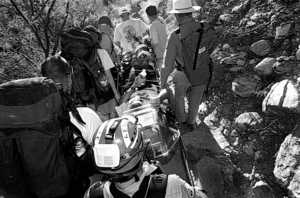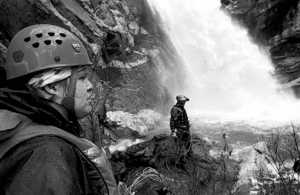 The
Southern Arizona Rescue Association is almost 50 years old, and one of
its rescues was in 1999, when association members helped a hiker with
an injured ankle near Seven Falls in Sabino Canyon. Group members
undergo extensive training.
Ben Kirkby / Arizona daily star 1999
More Photos (1):
SABINO CANYON REHABILITATION LICENSED NURSES Trades/Construction B&J Refrigeration HVAC Installers & Technicians Trades/Construction Krikawa Bench Jeweler/Goldsmith Trades/Construction American Fleet Service Auto Mechanic Computer Flowing Wells Schools Computer Technician Health Care AKDHC Nurse Technical Presidio Engineering Inc Civil AutoCAD Technician Tucson RegionS. Arizona's rescuers up to the challengeArizona Daily Star
Tucson, Arizona | Published: 08.13.2007
As a member of the Southern Arizona Rescue Association,
Cathy Wasmann has responded to more than 500 calls over the last 20
years about hikers lost, stranded or injured in the wilderness.
She along with countless others grab their hiking shoes, gear and
medical supplies and head out on search and rescue missions that can
last a couple of hours or a couple of days.
But Wasmann and the other members of SARA do not get paid for
their efforts, which are strenuous not only physically, but mentally
and emotionally as well. They volunteer their time saving others who
get into trouble.
"Almost every weekend, people get lost or are in need of
assistance in our mountains," said Brian Duffy, president of the rescue
association. "We have nearly a million people here in the Tucson area
and have very wild wilderness that's only a 45-minute drive from the
city. It's easy for people to go out and get overwhelmed by the
environment."
That's where the members of SARA come in. On average, they get
called out 100 times a year, mostly to conduct operations in the Santa
Catalina Mountains, such as their mission the weekend before last at
Seven Falls after a flash flood.
Members of SARA undergo extensive medical and technical training
before they are qualified to participate in field operations. Everyone
must hold current certifications in outdoor emergency care and CPR for
the professional rescuer.
Field-qualified members also participate in courses and
field-based training in all aspects of search and rescue techniques,
including vertical mountain rescue, desert and mountain search, flood
and river rescue, cave rescue and mine rescue.
Their medical and technical qualifications are continually
upgraded through regular monthly training as well as additional
classes.
Members also must supply their own personal equipment.
"Time management is an issue," said Wasmann, who during the day
works at the University of Arizona in plant pathology with the
department of plant sciences. "I'm putting as many hours into SARA as I
do into my job.
"There are endless committee meetings and trainings. Call-outs are really a small amount of the time with SARA."
But like all the other members, Wasmann prefers the missions over the behind-the-scenes work.
"I have had a lifelong interest in hiking, rock climbing and other
outdoor pursuits," she said. "With SARA, there's no script for what we
do. It's a few minutes of managing the situation and using our skills
to work together and make the rescue. It can be challenging at times,
but I find that to be a positive."
For Duffy, the organization president, one of the most challenging
missions he has been involved with in his seven years with SARA was the
rescue at Seven Falls Aug. 4 where dozens of hikers were stranded by
floodwaters and two were killed.
In addition to finding and recovering the two bodies, the
operation involved loading surviving hikers into helicopters and even
walking some out of the area on alternate routes.
One of those hikers, 14-year-old Casey Belford, said he is
grateful that SARA members are willing to donate their time to help
people like him and his friends in hazardous situations.
"I was talking to one of the guys who was leading us out of the
canyon, asking about their job and what the pay is like, and they said
they don't get paid, that they do it for free," said the soon-to-be
Rincon High School freshman. "I think it's really cool, because they
could be somewhere else sitting down watching TV, but they are helping
us."
● Contact reporter Alexis Huicochea at 629-9412 or ahuicochea@azstarnet.com.
|

 0 Comments on this story
0 Comments on this story